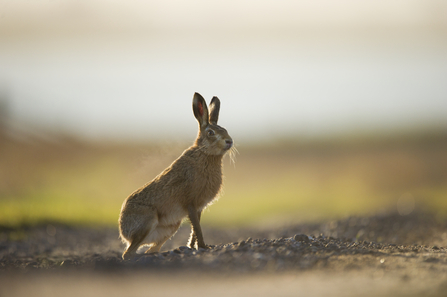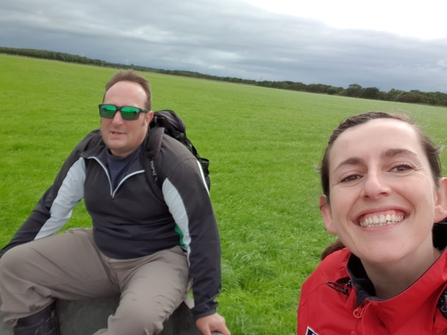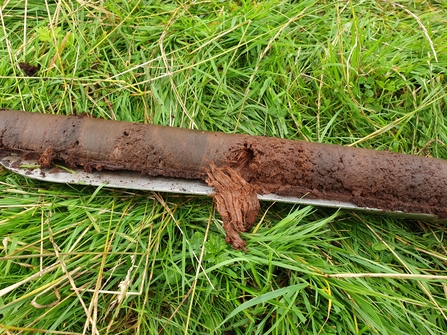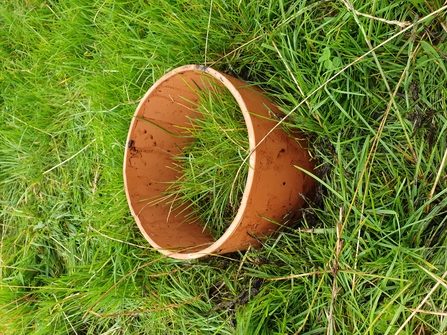Upon arrival at Winmarleigh Moss I met up with Lancashire Peatlands Initiative Project Officer, Mike Longden, who was to be my guide for the day. So off we went across the fields to the moss carrying with us a number of lengths of piping and what I was informed was a peat-corer, but looked to me more like an instrument of medieval torture!
Wild Walk Week - Mossy meanders: day three
Big skies over Winmarleigh - Jenny Bennion

Brown hare posing - Andrew Parkinson
Winmarleigh Moss is probably our regions’ best-preserved example of a lowland raised peat bog, after years of restoration work started by Natural England back in the 1990s and continuing to this day by Lancashire Wildlife Trust. Home to the original donor population of large heath butterflies that have been used in the reintroductions of the species onto both Heysham Moss and Astley Moss, the site is also home to common lizards, brown hares and peatland specialist plants including bog cranberry, sundews and gleaming tussocks of several varieties of amazing sphagnum mosses.
However, today most of our time would be spent on a number of the fields adjacent to the moss itself, including one that is being transformed into a pioneering carbon farm. Part of the EU-funded Care-Peat project, the Winmarleigh carbon farm is aiming to show how alternative land uses on peatlands can help support our fight against climate change.
The site of the Winmarleigh Carbon Farm before any work had been carried out - Jenny Bennion
What many people don’t realise is that a healthy peatland is able to absorb twice as much carbon as a forest, but as soon as that peatland is drained, damaged or degraded in any way, that carbon is then released into the atmosphere; contributing to greenhouse gas emissions and becoming a significant factor in climate change.
To create the carbon farm, a peatland site that had previously been drained and used for agriculture has been rewet via a number of ditch blocks and over the past few months the old turf and topsoil has been removed, ready for the creation of a series of low peat walls called bunds to be built, creating a network of cells and irrigation ditches.

Jenny and Mike hitching a ride on the back of a trailer
These cells will then be planted up with a permanent cover crop of sphagnum moss which, once established, will halt the release of carbon into the atmosphere and eventually start to actively absorb it, locking the carbon away into its peaty soils for millennia.
So, after hitching a cheeky lift on the back of the local farmer’s trailer out to the site of the carbon farm, we set to work. Our first job was to regulate the water levels on-site by wading into some of the cells and adjusting the angles of the overflow pipes (I only just hung onto my wellies!).
Then we set about the task of installing a new dip well onto a neighbouring field, to monitor the level of the water table. This involved driving the peat-corer into the ground before inserting a big plastic pipe from which readings can be taken. I found the peat cores themselves completely fascinating, unearthing perfectly preserved strands of heather and sphagnum moss from hundreds of years ago that had been preserved in the anaerobic conditions of the peat.

Peat core showing preserved vegetation - Jenny Bennion

Gas emission monitoring collar - Jenny Bennion
Our final job for the day was inserting a number of plastic collars into the ground which would then be attached to some very clever scientific kit and used to monitor exactly how much carbon was being released or absorbed over the next few years. Much fun was had jumping up and down on top of them to sink them far enough into the ground, and I was very impressed by Mike’s hula-hooping action to get them adjusted to just the right level!
After a picnic lunch listening to the water trickling into the drainage ditches from our recently adjusted overflow pipes, and watching clouds scudding across the huge skies that so many of our peatlands offer, it was time to head home. Somewhat wetter and dirtier than when I arrived, but having had a fascinating and utterly enjoyable day.
So, after three days of wild walks, my mossy meanders were over. Through my 30,000 steps I had encountered every weather type other than snow, and somehow had even got mud in my ears, but am left with an even more renewed love for these fascinating and incredibly important environments. I can’t wait to get back out there again… next week!
Don't forget to check out my other mossy meanders at Astley Moss and Highfield Moss, and Heysham Moss:

